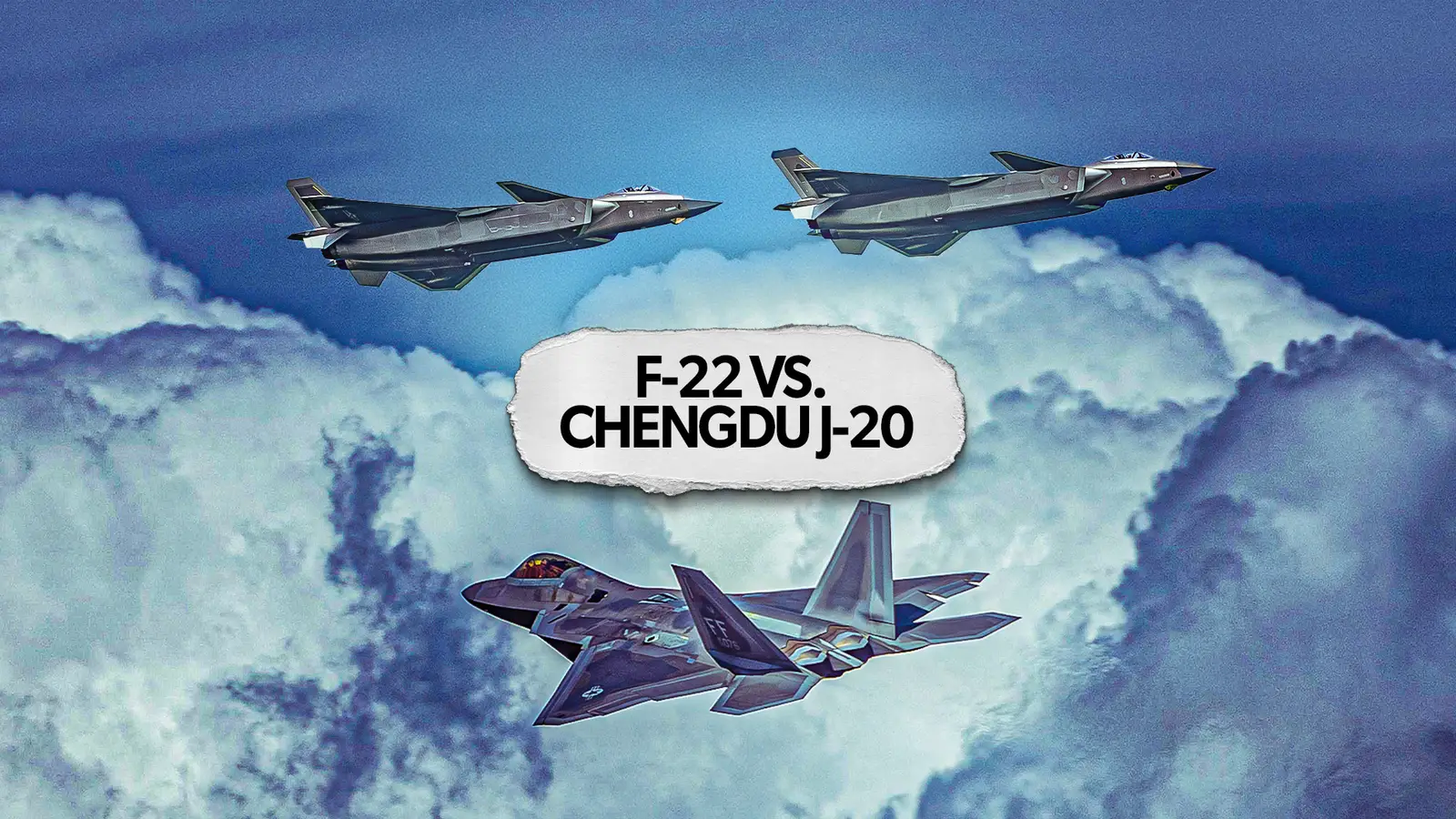
When we compare the United States’ F-22 Raptor with China’s J-20 Mighty Dragon, the image is of two aircraft designed for generally similar missions: air superiority, air defense penetration, and networked combat reconnaissance. Yet, the two are shaped by divergent strategic doctrines, industrial bases, and eras of design and technology.
The price of these awe-inspiring and fear-inducing weapons of the air is daunting to say the least. At a unit cost of about $150 million each, the US Air Force (USAF) procured 187 in total before the production line at Lockheed Martin’s Skunk Works shuttered. The mighty Raptor entered service in 2004, and with two decades under its belt, the wear and tear on the fleet is starting to show.
Beijing, meanwhile, has kept J-20 production active, and there are some indications that it is accelerating. Open-source estimates place the current inventory in the mid-hundreds and rising. Growing the fleet aligns with China’s push to patrol expansive maritime areas and project its power across the Asia-Pacific region.
The J-20 belongs to a later design era than the F-22. China’s military plans specifically target countering long-range US power projection in the Pacific. Its airframe is larger than the Raptor’s, a choice made to increase internal fuel and weapon bays. The notoriously lower-performing and less-efficient jet engines made in China make it a necessity to achieve parity. Ultimately, the Raptor is widely considered superior, but the margin by which it dominates is shrinking.
The Ultimate Fighter Jet
The F-22 Raptor is still the best fifth-generation fighter aircraft in operation today. In terms of speed, stealth, and combat performance (hyper maneuverability), no other platform now in service can match it. The Raptor is equipped with the most potent jet engines found in any fighter aircraft, as well as the best radar-absorbing coatings on the market.
After the F-22 was shut down, the air combat landscape around the world has changed significantly. Russia’s Su-57 and China’s J-20 stealth fighter are two examples of other 5th-Gen platforms that have appeared in both ally and enemy fleets. These near-peer actors attempt to undermine US air power, at least in the eyes of the public, by flaunting their new jets on social media in an effort to rally a renewed push for the manufacturing of platforms like the F-22. Media such as the Air and Space Forces Association have responded by publishing continued support for the F-22’s vital role in the US arsenal.
Though it is technologically limited to dated hardware and software refreshes, it does have a smaller radar cross-section, superior maneuverability, and greater weapons capability. The F-22 may yet provide the purest embodiment of pure air dominance. The J-20 represents a broader strategy. It uses size, range, and payload to hunt high-value assets like AWACS and aerial tankers. The F-22 was designed from day one to be the most lethal fighter on the planet, and it still is, at least until Boeing’s sixth-generation fighter arrives.
The F-22 Advantage
The F-22 Raptor is a product of the US Air Force’s Advanced Tactical Fighter program of the 1980s. It brought forth a never-before-seen combination of stealth, technology, and firepower. Instead of striving for greater Mach numbers, engineers developed a design that minimizes radar signals by using unique surface treatments and concealing armaments internally.
Without afterburners, the Raptor’s Pratt & Whitney F119 engines can sustain supersonic flight in what has been dubbed “supercruise.” The downside of their stealth-oriented intake geometry and exhaust nozzles limits their maximum speed.
Its internal missile bays reduce drag and radar signature, and the jet’s thrust-vectoring nozzles and advanced fly-by-wire let it outmaneuver its adversaries in close engagements. Captain Chris Bergtholdt, 1st Operations Support Squadron, gave these comments after the F-22’s first trans-Atlantic deployment:
“A small piece of the F-22’s capabilities lie in its ability to perform maneuvers that other fighters cannot perform – and at very low airspeeds.”
Other features like its unparalleled radar-absorbent material (RAM), advanced sensors, and the capacity for multirole capabilities combine to perfect its combat performance and make the Raptor the gold standard for 21st-century fighter jet performance.
The Mighty Dragon
China’s J-20 Mighty Dragon was conceived as a long-range, low-observable interceptor that could contest US and allied air operations across the Western Pacific. Its design is a broad delta wing set behind a prominent canard with ample internal volume for fuel. Its unrefueled combat radius is exceptionally long, as China lacks the tanker support that the USAF and Western forces have.
The People’s Liberation Army Air Force (PLAAF) of China could have as many as 210 stealth J-20 Mighty Dragon fighters, as reported by World Directory of Modern Military Aircraft (WDMMA). Its range allows the J-20 to loiter on likely flight paths of tankers, AWACS, airborne early warning (AEW) aircraft, or standoff bombers and to threaten them with extended-range PL-15 missiles. Roughly matching the F-22’s carriage of six AIM-120s but with a reported seeker range that is unverified, but at least good for shots beyond 100 kilometers.
Low observability is central to its mission profile. It features serpentine air intakes, serrated bay doors, and edge alignment to reduce frontal radar returns. The canard and overall airframe size, and substandard RAM coating mean its signature is less suppressed than the Raptor’s. In practice, this means the J-20 is expected to be very difficult to detect from ahead, which is crucial for closing in on support aircraft, yet somewhat less elusive from the side or rear.
The Mighty dragon mounts an active electronically scanned array (AESA) and an electro-optical/infrared search-track turret just ahead of the canopy, and a distributed aperture system embedded around the fuselage. Those sensors feed a mission computer suite that fuses radar, optical, and electronic data into a single picture and can pass it over secure datalinks to other Chinese jets or missile batteries.
The Raptor In 2025
The F-22 emerged from late-Cold War requirements that aimed to counter front-line Soviet fighters. Its designers pursued an aggressive blend of low radar observability, extreme agility through two-dimensional thrust-vectoring nozzles, and sustained supersonic flight without afterburner, known as supercruise. Operational experience over nearly two decades has confirmed that combination’s lethality.
Although some of the powerful Raptors may be nearing the end of their useful life, this does not mean that the platform has become obsolete. Air & Space Forces Magazine reported that the F-22 achieved the longest known hit with an AIM-120D AMRAAM just about a week ago. The F-22 is a dominant air dominance fighter because of its internally-carried air-to-air missiles, which include the BVR (beyond visual range) missile.
Given the danger posed by any stealth fighter in the hands of a hostile, near-peer nation, the USAF urgently needs a fifth-generation fighter. The F-22 fleet faces a challenging task in terms of air policing and deterrence due to the large number of PLAAF J-20s and Russia’s forces located half a world away. Removing airframes would put further strain on the current fleet, which provides LM’s Skunk Works branch with compelling arguments for its modernization initiative.
China’s Fire Breather
Early J-20s used Russian engines that limited cruise speeds and high-G maneuvering. Newer airframes use the Chinese domestic engines, which permit short periods of supersonic flight without afterburner. The forthcoming WS-15 may push supercruise closer to Mach 1.7, which would be comparable to the F-22’s demonstrated Mach 1.6 speed. The J-20’s large wing means it is unlikely to match the Raptor’s turn rate even with new propulsion, but it does close the gap more than ever before.
The J-20’s combat value lies in its ability to arrive on station rapidly at extended ranges, remain electronically concealed, volley long-reach missiles, and withdraw under the cover of robust electronic warfare (EW) cover. The F-22 still sets the benchmark for dogfighting maneuverability and all-aspect stealth, but the J-20 occupies a different tactical niche. It is a stealth hunter of high-value assets and a gatekeeper of contested airspace, designed to stretch the adversary’s defenses and escape using hit-and-run tactics.
Who Reigns Supreme
The F-22 Raptor and J-20 Mighty Dragon, when compared head-to-head, contrast in design philosophies that would influence engagement outcomes according to tactical conditions. With a lower radar cross-section from all angles and better close-range maneuverability thanks to thrust-vectoring and aerodynamics, the F-22 has the advantage. Outstanding sensor capability is provided by its tried-and-true radar and sensor package, which has been refined over decades of operational experience.
The J-20 counters with long-range PL-15 missiles that can engage targets beyond visual range. Its bigger airframe gives it a greater fuel capacity and a wide range of weapon loadouts, but at the expense of less agility and increased detectability from angles other than head-on. In combat, distance and engagement geometry would determine victory.
Either jet might have the first shot at a BVR missile launch, depending on conditions. Nonetheless, the F-22’s combination of reduced observability, a better turning radius, and combat-tested systems would be decisive in close to medium range. The apparent doctrine of the PLAAF appears to be to launch-and-leave, letting the missiles do the work and turning their noses back home as soon as they launch. Although unlikely to unfold, should the two ever enter the merge, all signs point toward a victory for the Raptor.



